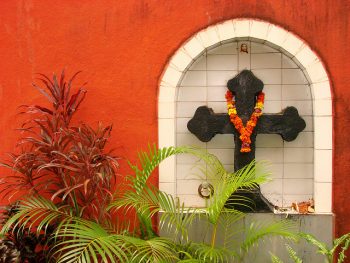Portuguese in Hindi (Part 3): A Tale of Trade, Travel and Cultural Tension Posted by Rachael on Jun 26, 2017 in Hindi Language, Uncategorized
Welcome back/आपका स्वागत है (Aapka svaagat hai)/Bem vindo de volta! Parts 1 and 2 of this blog series were devoted to the history of Portuguese rule and presence in India; however, the end goal of this series was to discuss the Portuguese language’s influence on Hindi, which will be addressed in this entry. Although the majority of Portuguese interactions with the subcontinent occurred in South and Central India, where mostly Dravidian languages (Hindi as well as Marathi, with which Portuguese came into extensive contact, are Indo-European languages) are spoken, Portuguese nonetheless had an influence on Hindi as filtered through these Dravidian languages as well as Arabic (remember there were Arab traders competing with the Portuguese to capture the South Indian market).
First of all, it may be helpful to enumerate some of the word categories of which Hindi is primarily composed:
- Tatsam (तत्सम, means “same as that”): These are words that are written exactly the same as their counterparts in Sanskrit, with the exception of final case inflections (which are not present in Hindi). This category is comprised of words that made their way into Hindi from Sanskrit via Prakrit as well as Sanskrit words later added to the Hindi lexicon in a movement to “purify” (that is, Sanskritize) Hindi (this kind of Sanskrit-inflected Hindi is known as “शुद्ध हिंदी/Shuddh/Pure Hindi”). Yet, if you know or are familiar with Sanskrit, you must remember that these words are pronounced according to Hindi norms, not according to Sanskrit rules. Examples: नाम/naam/name, कर्म/karm/deed/action, प्रार्थना/praarthnaa/prayer, भाषा/bhasha/language, प्रेरणा/prernaa/inspiration.
- Tadbhav (तद्भव, means “born of that”): These are “native” Hindi words derived from Sanskrit after undergoing some changes. An example is the Sanskrit कर्म/karm (deed), which then becomes the Pali कम्म/kamma and eventually the Hindi काम/kaam (work).
- Videshi (विदेशी, foreign words): These are loanwords from non-indigenous languages, such as Persian, English, Arabic and Portuguese. Some examples include कमेटी/kameti (committee, from English) and साबुन/saabun (soap, from Arabic). We will be talking mostly about this type of word in this blog!
And now, here are some examples of Hindi words that originally came from Portuguese:
- कमरा/kamraa (masc. noun): room. From the old Portuguese “camara” (or “quarto” in Brazilian Portuguese). Example sentence: उस कमरे में कौन है अभी?/Us kamre me kaun hai abhi?/Who is in that room right now?
- अलमारी/almaari (fem. noun): cupboard/wardrobe/armoire. From Portuguese “armário.” Example sentence: मैं हमेशा अपना ज़ेवर अलमारी में रखती हूँ/Main hameshaa apnaa zevar almaari me rakhti huun/I always keep my jewelry in the cupboard/wardrobe.
- गिरजा/girjaa (masc. noun): church. From Portuguese “igreja.” Example sentence: उस पहाड़ी के पीछे एक बहुत सुन्दर गिरजा है जो अतीत में पुर्तगालियों ने बनाया था/Us pahaari ke piche ek bahut sundar girjaa hai jo ateet me Purtgaaliyon ne banaya tha/Behind that hill is a beautiful church that the Portuguese constructed in the past.
- अनन्नास/anannas (noun): pineapple. From the Portuguese “ananás.” Example sentence: मुझे अनन्नास चाट मसाले के साथ बहुत अच्छा लगता है/Mujhe anannaas chaat masaale ke saath bahut accha lagta hai/I really like pineapple with chaat masala (a spice mixture used in chaat, which is a type of savory snack).
- आलपीन/aalpeen (masc. noun): pin. From the Portuguese “alfinete,” which may in turn be from Arabic and/or English “pin.” Example sentence: दर्ज़ी कुरता सीने के लिए बहुत सारे आलपीनों का इस्तेमाल करता है/Darzi kurtaa seene ke liye bahut saare aalpeeno kaa istemaal kartaa hai/The tailor uses a lot of pins to sew the kurta.
- बाल्टी or बालटी/baaltee (fem. noun): bucket. From the Portuguese “balde.” Example sentence: सावधान रखो! बाल्टी में बहुत ज़्यादा पानी है/Saavdhaan rakho! Baalti me bahut zyaada paani hai/Be careful! There’s too much water in the bucket.
- फीता/feetaa (masc. noun): lace (as on a shoe), tape, ribbon. From the Portuguese “fita.” Example sentence: जब मैं छोटी थी, (तो) मुझे फीते बहुत पसंद थे/Jab main choti thi, (to) mujhe feete bahut pasand the/When I was little, I really liked ribbons.
- चाबी/chaabee (fem. noun): key. From the Portuguese “chave.” Example sentence: घर से निकलते ही, उसको एहसास हुआ कि वह अपनी चाबियाँ भूल गया था/Ghar se nikalte hi, usko ehsaas huaa ki voh apni chaabiyaan bhuul gayaa thaa/As soon as he left the house, he realized that he had forgotten his keys.
- दुविधा/duvidhaa (fem. noun): dilemma, suspense, uncertainty. Possibly related to the Portuguese “dúvida” (noun) and “duvidar” (verb), although the connection is unclear. Example sentence: (तो) मेरे सामने दुविधा आ पड़ी जब दो आदमी मुझे शादी करना चाहते थे/(To) mere saamne duvidhaa aa pari jab do aadmi mujhe shaadi karnaa chahte the/A dilemma befell me when two men wanted to marry me.
I hope you enjoyed this blog series about the many ways in which the Portuguese influenced the culture, history and languages of the subcontinent! One last interesting fact I’ll leave you with is that many of the Hindi words that are misidentified as being of Portuguese origin are actually from Arabic and, to a lesser extent, Persian, indicating the great influence both Arabic and Persian have had on Portuguese as well as Hindi!

Build vocabulary, practice pronunciation, and more with Transparent Language Online. Available anytime, anywhere, on any device.






